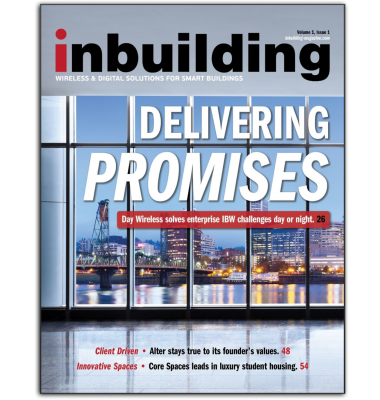Distributed Antenna Systems to Boost Cell Phone Reception
Mobile coverage has become essential to daily life. When checking Facebook, making dinner plans or checking in on family after a disaster, cell phone users don’t want to think about whether they have a strong signal.
Poor coverage can make it difficult to lease an apartment or find tenants for an office building. Hotel guests might walk out two hours after checking in if they discover they can’t access work emails. As a result, many property owners now think of cellular antenna systems that boost signals as a necessity, not a luxury.
"Seamless in-building cellular coverage is, for some time now, considered the fourth utility," says Dennison Jurawan, technical sales manager and senior RF design engineer at JDTECK, a provider of cellular signal enhancement solutions.
"The mobile device is now considered 'part of the human anatomy' and is expected to work everywhere and anywhere life happens."
But finding a company that can provide a quality system at a fair price is a challenge for many owners. Integrators might purchase individual components from multiple manufacturers that don’t work well together, or they may lack the experience to create a coherent system. That can lead to overly complex and expensive distributed antenna systems (DAS) that doesn’t provide the advertised amount of coverage or system performance. Some property owners sour on the technology while others turn to companies such as JDTECK to fix the problem.
Jurawan recently came across an installation in the penthouse of a 42-story building in Chicago that ticked the boxes on many of the common problems he’s seen with poorly designed DAS systems. The customer paid $60,000 for a 12-antenna system in a 6,000-square-foot space that did not even work properly.
Had the customer first gone to JDTECK, Jurawan says, they could have designed a carrier-grade digital solution that provides full coverage for a fraction of the cost. It pains him to see just how much unsuspecting persons have been taken advantage of even if they appear to have the means. "We seem to always come across these very difficult systems that have been poorly engineered or badly installed," he says. It’s one of the reasons why he aims to help persons understand the formula for how DAS systems are spec’d. This includes the volume of the space that needs to be covered, estimated number of simultaneous connections, where the signal is being sourced from and the mode of distribution (over the air or micro cell/passive or active). This quickly helps expose overpriced bills of materials (BOM).
As more companies offer DAS, situations like the one in Chicago will become more prevalent, unfortunately. The increase in misinformation around DAS will make it difficult for property owners to wade through the potential solutions to find a system that works for their environment. By demonstrating it can deliver robust systems that work, JDTECK has earned the trust and repeat business from past and current customers, including local and federal government agencies, Jurawan says.
The best evidence of that trust is JDTECK’s ability to cultivate long-time customers. It’s not unusual for a customer that needs a system upgrade to reach out to JDTECK by replying to an email that was originally sent seven to 10 years earlier. "It’s amazing when someone that purchased your product, which they’re really happy with, keeps your contact email for that length of time, " he says.
When you’re a business genu-inely set up to help people, that’s your drive and your motivation, " Jurawan continues.
"The biggest ‘thank you’ is a referral or testimonial, so we focus on letting the quality of our solutions do the advertising for us. It’s a wonderful feeling when they come back many years after and want to get some-thing else done or another location covered. It’s confirmation of a job well done!"
TURNKEY SOLUTIONS
In-building cellular systems were still in their infancy when JD-TECK started in 1999. There were no clearly defined process-es or benchmarks for how the business should work, so pioneers such as JDTECK had to create the procedures and system designs from the ground up. "It allowed us to get a very in-depth understanding of [the technology] because there wasn’t a lot of white papers around, there wasn’t a lot of history, " Jurawan says. "We had to create our own history. "
To develop best practices and build its knowledge base, JD-TECK needed to be methodical in its approach and documentation. Knowing what settings worked on a project and which ones needed tweaking helped it to get better with every project.
Many of those procedures ended up becoming industry standard, which Jurawan sees as validation of the company’s expertise. "As more and more processes became established, I recognized that this lined up nicely with what we had already figured out," he notes.
JDTECK manufactures its own equipment and works with property owners to develop turnkey cellular coverage-boosting systems for residential and office complex-es, outdoor spaces, oil rigs, hotels, big-box stores and hospitals. It also works directly with cellular service providers, both nationally and globally. Recent projects include upgrading a coverage system for an aerospace/defense contractor’s administrative office in Virginia, deploying a system at the National Institute of Standards and Tech-nology (NIST) campus and retail locations for the Army and Air Force Exchange Service.
Well-vetted and qualified third-party integrators handle the actual installation of JDTECK’s systems. Many work exclusively on JDTECK-designed solutions. In these cases, the integrators receive a detailed set of engineered plans, showing the correct placement and value of each and every component within the system. "The company also sells its equipment to integrators who design their own coverage systems, but we are also structured to engineer a carefully customized solution directly for the customer, " Jurawan says.
To encourage integrators to follow its standards, JDTECK offers discounts and access to its expertise, equipment and customer and technical support infrastructure. That results in improved quality of engineering, product and installation. "It’s a three-pronged approach to a successful DAS," Jurawan says. "If any one of those pieces are missing, you will have problems."
Manufacturing its own equipment gives JDTECK a distinct advantage over most other solutions providers. The company sets its own benchmarks for features and performance and can implement future-proofing compatibilities based on where it thinks the industry is headed. Feedback from customers and system integrators is highly encouraged and goes directly back to JDTECK's R&D group for product enhancements and improvements.
JDTECK’s latest product launch is a new line of quad band digital repeaters, designed to be user-friendly so that the customer’s own IT manager can understand what the system is doing without needing to consult with JDTECK. It’s the kind of transparency Jurawan believes instills trust in the client. We want a product that is very easy for the end-user to interface with," Jurawan says. "What good is an amazing product if it is difficult to use?"
The new repeaters will be a springboard into other digital products now under development, such as digital repeaters for public safety applications and a fiber solution based on JDTECK’s digital platform.
"The end-result is an impeccably neat, completely tested and working-as-intended DAS solution."
"Because you are dealing directly with the manufacturer, we have a personal, vested interest in the customer’s or integrator’s success," Jurawan says. "We complete a high-level of testing to ensure all the components in the DAS play well together. It’s the reason that the system integrators who have partnered with JDTECK have been able to outperform and underbid the competition and stay ahead of the game."
Controlling every aspect of the implementation, from manufacturing and design to quoting and implementation, ensures that JDTECK’s solutions work as intended. The company possesses a deep understanding of cellular technology, as well as its own products and limitations, allowing it to bring a complete knowledge base to its customers. "There are some [solution providers] who do not have a solid grasp of this technology and are still presenting solutions that, when examined intently, are inherently flawed," Jurawan says.
THINKING AHEAD
JDTECK’s systems not only perform better, but the company’s intimate understanding of its systems means they can be installed much faster than the industry standard. Many components can be prefabricated so they can be put in place with minimal disruption to the client’s operation.
An entire turnkey system for one of its national big-box store customers in the 150,000 square foot range, for example, can be completed in just four nights after store closing. "Four consecutive nights and we’re done and that’s not because it was a rushed, poorly executed installation, leaving the customer with shoddy workmanship," Jurawan says. "Each installation JDTECK is contracted for is reviewed and optimized as necessary by the company before the installation team leaves the customer’s location to ensure optimal performance is achieved. The end-result is an impeccably neat, completely tested and working-as-intended DAS solution." Some of these installations can be viewed on JDTECK’s website.
Published by SmartBuild | Tel: 312.676.1105
On behalf of JDTECK © 2017 SmartBuild. All rights reserved.
Drop File





